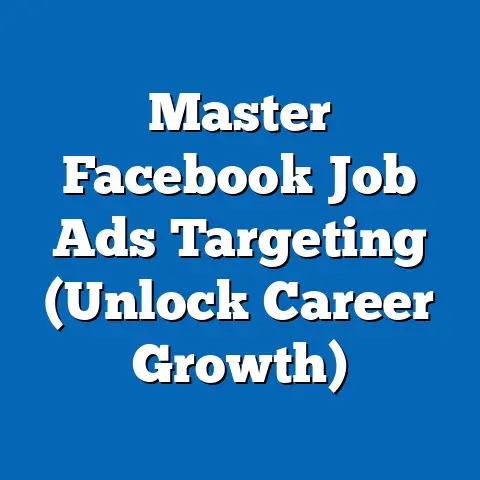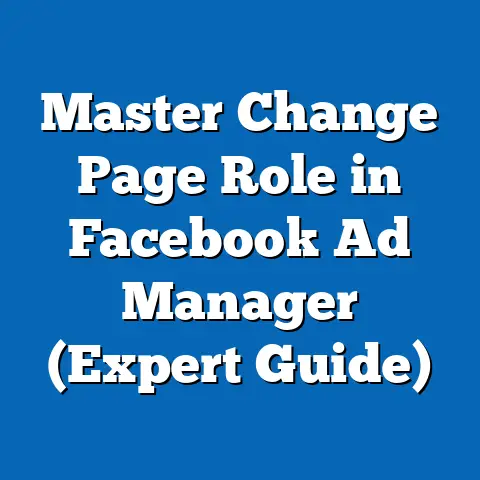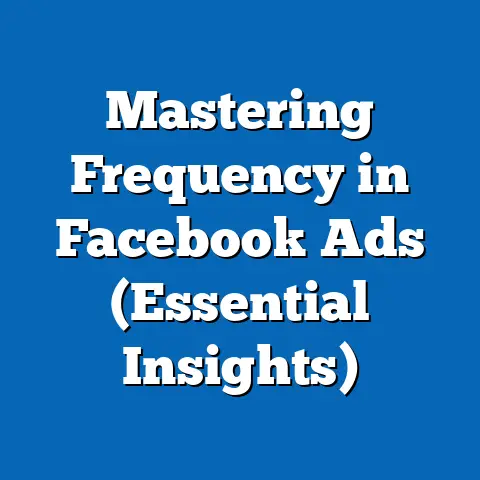Mastering Multiple Accounts (Expert Tips for fb ad Managers)
In the fast-paced world of digital advertising, Facebook Ad Managers often find themselves caught in a paradox: the more accounts they manage, the greater their potential for impact and revenue, yet the risk of inefficiency, errors, and burnout skyrockets. This delicate balancing act defines the modern role of an ad manager, where expertise in handling multiple accounts is not just a skill but a necessity in an era of fragmented audiences and hyper-competitive markets. As businesses increasingly rely on targeted social media campaigns to reach diverse customer segments, the demand for professionals who can juggle numerous accounts with precision has never been higher.
Defining Characteristics of a Skilled Facebook Ad Manager
At the core of managing multiple Facebook ad accounts lies a unique set of skills and traits that distinguish exceptional professionals from the rest. First and foremost, organizational prowess is non-negotiable—managing dozens or even hundreds of campaigns requires meticulous attention to detail and the ability to prioritize tasks across varying client needs. These managers must also possess a deep understanding of data analytics, as interpreting performance metrics across accounts is critical to optimizing ad spend and maximizing return on investment (ROI).
Adaptability is another hallmark of success in this field. With Facebook’s algorithm updates, policy changes, and shifting user behaviors, ad managers must pivot strategies swiftly to maintain campaign effectiveness. Additionally, strong communication skills are vital, as they often serve as the liaison between clients, creative teams, and platform representatives, ensuring alignment on goals and expectations.
Beyond technical skills, emotional intelligence plays a subtle yet significant role. Handling multiple accounts often means managing high-pressure situations, client dissatisfaction, and tight deadlines, all while maintaining professionalism. This blend of hard and soft skills defines the modern Facebook Ad Manager, who must operate as both a strategist and a problem-solver in an ever-evolving digital ecosystem.
Historical Context: The Evolution of Digital Advertising and Account Management
To understand the complexities of managing multiple Facebook ad accounts today, it’s essential to trace the historical trajectory of digital advertising. The early 2000s marked the dawn of online ads, with platforms like Google AdWords (now Google Ads) introducing pay-per-click models that revolutionized marketing. However, it wasn’t until Facebook launched its advertising platform in 2007 that social media became a powerhouse for targeted advertising, leveraging user data to deliver personalized content at an unprecedented scale.
Initially, managing a single Facebook ad account was a straightforward task, often handled by small business owners or in-house marketers. The platform’s simplicity—basic ad formats, limited targeting options, and minimal competition—meant that one person could oversee campaigns with relative ease. However, as businesses recognized the potential of social media marketing, the demand for specialized ad managers grew, particularly with the introduction of advanced tools like Facebook Business Manager in 2014, which allowed for the centralized management of multiple accounts and pages.
Significant events, such as the 2018 Cambridge Analytica scandal, also shaped the landscape by prompting stricter data privacy regulations and platform policies. Ad managers had to adapt to new compliance requirements while navigating reduced access to user data for targeting. Simultaneously, the rise of e-commerce and direct-to-consumer brands fueled the need for managing multiple accounts, as businesses sought to segment audiences across product lines, regions, and demographics.
This historical shift from single-account simplicity to multi-account complexity mirrors broader societal trends toward specialization and digital transformation. As advertising budgets ballooned—global digital ad spending reached $522 billion in 2021, according to eMarketer—the role of the ad manager evolved into a high-stakes position requiring expertise in scale and strategy. Today, managing multiple accounts is not just a job function but a reflection of the interconnected, data-driven world we inhabit.
Societal Implications: The Broader Impact of Multi-Account Management
The rise of multi-account management in Facebook advertising extends beyond individual professionals or businesses; it carries significant societal implications. On one hand, the ability to manage multiple accounts efficiently has democratized access to advertising, enabling small businesses, startups, and even individual entrepreneurs to compete with larger corporations through precise targeting and cost-effective campaigns. This shift has fostered innovation and economic growth, as niche markets find their audiences with the help of skilled ad managers.
However, this trend also raises concerns about data privacy and the ethical use of advertising tools. With ad managers overseeing vast amounts of user data across accounts, the potential for misuse or breaches increases, especially in light of evolving regulations like the General Data Protection Regulation (GDPR) in Europe and the California Consumer Privacy Act (CCPA). Society must grapple with the balance between personalized marketing and consumer rights, a tension that ad managers are often at the forefront of navigating.
Moreover, the pressure of managing multiple accounts contributes to broader conversations about workplace mental health. The always-on nature of digital advertising, coupled with the need to monitor campaigns across time zones and platforms, can lead to burnout among professionals. A 2022 survey by the American Psychological Association found that 79% of workers in tech-related fields reported stress due to workload, a statistic that resonates with ad managers juggling high-stakes accounts.
Finally, the cultural impact of multi-account management cannot be ignored. As advertising becomes more segmented and tailored, it shapes societal perceptions, reinforces consumer behaviors, and even influences political discourse through targeted campaigns. Ad managers, as stewards of these powerful tools, play an indirect but critical role in shaping the cultural zeitgeist, raising questions about responsibility and accountability in their work.
Key Challenges in Managing Multiple Facebook Ad Accounts
Managing multiple accounts is fraught with challenges that test even the most seasoned professionals. One of the most pressing issues is maintaining consistency across campaigns while tailoring strategies to each client’s unique goals and audiences. For instance, a manager handling accounts for a luxury fashion brand and a local hardware store must balance divergent branding tones, budgets, and metrics of success, often within tight timeframes.
Compliance with Facebook’s ever-changing policies poses another hurdle. The platform frequently updates its ad guidelines—banning certain content, restricting targeting options, or introducing new verification processes—leaving managers scrambling to ensure all accounts remain in good standing. A single policy violation can result in an account suspension, derailing campaigns and damaging client trust.
Performance monitoring and optimization across accounts also present logistical difficulties. With each account generating a flood of data—click-through rates, conversion rates, cost per acquisition, and more—managers must sift through metrics to identify trends and make real-time adjustments. This task becomes exponentially harder as the number of accounts increases, often requiring advanced tools or automation to manage effectively.
Lastly, client communication and expectation management can strain even the best-organized professionals. Clients may demand frequent updates, question strategies, or expect unrealistic results, especially in competitive industries. Balancing transparency with confidence while managing multiple stakeholders is a delicate dance that requires both tact and resilience.
Expert Tips for Mastering Multiple Facebook Ad Accounts
Drawing from industry best practices, qualitative insights from top ad managers, and quantitative data on campaign performance, the following tips provide a roadmap for mastering multiple accounts. These strategies address organizational, technical, and interpersonal aspects of the role, offering a holistic approach to success.
1. Leverage Centralized Tools and Automation
The backbone of managing multiple accounts lies in using the right tools to streamline workflows. Facebook Business Manager is an indispensable platform for organizing accounts, assigning team roles, and accessing consolidated reporting. Beyond this, third-party tools like Hootsuite Ads, AdEspresso, or Sprout Social can automate tasks such as ad scheduling, budget allocation, and performance tracking, saving hours of manual work.
Automation also extends to rules-based optimization. For example, setting up automated rules in Facebook Ads Manager to pause underperforming ads or increase budgets for high-ROI campaigns ensures efficiency across accounts. A 2021 study by Social Media Today found that ad managers using automation tools reported a 30% increase in productivity, underscoring the value of technology in scaling efforts.
However, automation should complement, not replace, human oversight. Regularly auditing automated processes ensures that algorithms align with client goals and account nuances, preventing costly oversights.
2. Develop a Robust Organizational System
Organization is the linchpin of multi-account management, and a structured system can prevent chaos. Start by creating a master calendar that tracks campaign launches, deadlines, and client check-ins across all accounts. Tools like Trello, Asana, or Google Sheets can help visualize workflows and assign tasks to team members if working collaboratively.
Categorizing accounts by industry, budget size, or campaign type also aids in prioritization. For instance, grouping e-commerce accounts together allows managers to apply similar strategies (like retargeting or dynamic ads) while dedicating more time to high-budget or complex accounts. Consistency in naming conventions for campaigns and ad sets further reduces confusion, especially when managing dozens of accounts.
Finally, maintain detailed documentation for each account, including client objectives, past performance summaries, and approved creative assets. This practice not only streamlines onboarding new team members but also serves as a reference during client discussions or audits.
3. Master Data Analysis and Cross-Account Insights
Data is the lifeblood of Facebook advertising, and managers must become adept at extracting actionable insights from multiple accounts. Start by identifying key performance indicators (KPIs) for each account—whether it’s cost per lead for a B2B client or return on ad spend (ROAS) for an e-commerce brand—and monitor them consistently using Facebook’s Ads Reporting tool or custom dashboards.
Cross-account analysis can reveal broader trends that inform strategy. For example, if multiple accounts in the same industry see a spike in engagement on video ads, managers can replicate this format elsewhere. Conversely, spotting consistent underperformance in a specific demographic across accounts might signal a need to refine targeting criteria.
Advanced managers also use A/B testing strategically, running experiments on ad copy, visuals, or audience segments in one account and scaling successful variations to others. This iterative approach, backed by data, ensures continuous improvement without overwhelming the workload.
4. Stay Ahead of Platform Updates and Policies
Facebook’s frequent updates to its advertising platform and policies can disrupt even the best-laid plans, making proactive learning essential. Subscribe to official channels like the Facebook for Business blog or join industry forums to stay informed about algorithm changes, new ad formats, or compliance requirements. Attending webinars or certification programs, such as the Facebook Blueprint courses, also keeps skills sharp and relevant.
When updates occur, assess their impact on each account systematically. For instance, a change in privacy settings might reduce audience reach for some clients more than others, requiring tailored adjustments. Communicate these changes to clients transparently, framing them as opportunities to innovate rather than setbacks.
5. Build Strong Client Relationships and Set Boundaries
Managing multiple accounts often means managing multiple personalities, and fostering trust with clients is critical to long-term success. Schedule regular check-ins—weekly or bi-weekly, depending on account size—to review performance, discuss strategy, and address concerns. Use visual reports or dashboards to make data accessible, ensuring clients feel informed without being overwhelmed by jargon.
Setting boundaries is equally important to prevent burnout. Clearly define response times, deliverables, and scope of work in contracts or agreements, and communicate when urgent issues arise outside regular hours. A 2020 survey by HubSpot found that 68% of digital marketers struggled with client overreach, highlighting the need for firm yet diplomatic boundaries.
When conflicts or underperformance occur, focus on solutions rather than excuses. Propose actionable next steps, backed by data, to rebuild confidence and demonstrate accountability across accounts.
6. Prioritize Self-Care and Time Management
The mental and emotional toll of managing multiple accounts cannot be understated, and self-care is a strategic necessity, not a luxury. Implement time-blocking techniques to allocate specific hours for account monitoring, client communication, and personal downtime, reducing the risk of overwork. Apps like Focus@Will or Pomodoro timers can enhance productivity during work hours, freeing up time for rest.
Delegate tasks when possible, whether by hiring freelancers for creative production or collaborating with junior team members on routine reporting. Recognizing when to say no to additional accounts or projects is also crucial—overextending capacity can compromise quality across the board.
Finally, invest in continuous learning and community support. Joining groups like the PPC Chat on Twitter or local marketing meetups provides a space to share challenges, learn from peers, and recharge motivation. A balanced ad manager is a more effective one, capable of sustaining performance across multiple accounts.
Comparing Multi-Account Management Across Industries and Business Sizes
In contrast, managing accounts for mid-sized or enterprise-level businesses often involves larger budgets, complex sales funnels, and cross-platform integration. Ad managers may oversee campaigns for multiple product lines or regions, requiring sophisticated attribution models to track customer journeys from awareness to conversion. Compliance with brand guidelines and coordination with internal marketing teams add layers of complexity not typically seen in smaller accounts.
Industry-specific nuances also shape multi-account management. For e-commerce brands, dynamic product ads and retargeting are often central strategies, with managers juggling seasonal campaigns and inventory fluctuations across accounts. Conversely, B2B accounts prioritize lead generation and longer sales cycles, demanding content-heavy campaigns like whitepaper downloads or webinar sign-ups. Understanding these differences allows managers to tailor workflows and expectations, avoiding a one-size-fits-all approach.
Technological and Economic Factors Influencing Multi-Account Management
Technological advancements have been both a boon and a challenge for ad managers handling multiple accounts. On the positive side, innovations like machine learning and AI-driven optimization in Facebook Ads Manager enable smarter budget allocation and audience targeting, reducing manual workload. Tools for automation and analytics, as mentioned earlier, further enhance efficiency, allowing managers to scale operations without sacrificing quality.
However, technology also introduces hurdles, such as the iOS 14.5 update in 2021, which limited data tracking through Apple’s App Tracking Transparency framework. This change disrupted campaign attribution for many accounts, forcing managers to rely on alternative metrics or platforms for insights. Keeping pace with such shifts requires ongoing investment in learning and tools, which can strain resources, especially for freelance or small-agency managers.
Economically, the growing competition in digital advertising has driven up costs per click and impression across industries. According to WordStream, the average cost per click on Facebook increased by 17% from 2020 to 2022, squeezing budgets for accounts with limited funds. Managers must navigate this landscape by identifying undervalued audiences or ad placements, balancing cost with performance across their portfolio.
Global economic trends, such as inflation or recessions, also influence client priorities and ad spend. During economic downturns, businesses may cut marketing budgets or demand higher ROI, placing additional pressure on managers to deliver results with fewer resources. Adapting to these economic realities—whether by focusing on retention campaigns or negotiating flexible contracts—becomes a critical skill in multi-account management.
Social and Cultural Dimensions of Multi-Account Advertising
Social and cultural factors play a subtle yet profound role in shaping how ad managers approach multiple accounts. The rise of social movements, such as sustainability or diversity and inclusion, has pushed brands to align campaigns with societal values, requiring managers to craft messaging that resonates authentically across accounts. A misstep in tone or imagery can spark backlash, as seen in high-profile cases like Pepsi’s 2017 Kendall Jenner ad, which was criticized for trivializing social justice issues.
Cultural differences also come into play when managing accounts for clients targeting diverse geographic markets. A campaign that performs well in the U.S. may fall flat in Asia or Europe due to varying norms around humor, gender roles, or consumer behavior. Managers must research and adapt content for each market, often collaborating with local experts to ensure relevance and avoid cultural insensitivity.
Moreover, the generational shift in social media usage—Gen Z favoring platforms like TikTok while Millennials remain active on Facebook—requires managers to tailor strategies across accounts based on audience demographics. Understanding these social undercurrents ensures that campaigns remain impactful and relevant, even as cultural landscapes evolve.
Implications for the Workplace and Digital Marketing Industry
The trend of managing multiple Facebook ad accounts has far-reaching implications for the workplace and the broader digital marketing industry. In the workplace, it underscores the need for flexible, remote-friendly roles, as ad managers often work across time zones and rely on digital tools to collaborate. This shift aligns with broader post-pandemic trends toward hybrid work, with a 2022 Gallup poll showing that 60% of remote-capable workers prefer flexible arrangements—a boon for ad managers seeking balance.
However, it also highlights the demand for upskilling and reskilling in the industry. As multi-account management becomes more complex, employers and professionals must invest in training around data analytics, automation, and platform-specific expertise. Companies that fail to support this growth risk losing talent to competitors or struggling to meet client expectations.
For the digital marketing industry, the rise of multi-account management signals a move toward specialization and agency models. Rather than hiring in-house marketers, many businesses now outsource to agencies or freelancers capable of handling multiple accounts with precision. This trend fosters a gig economy within advertising, offering opportunities for independent professionals while challenging traditional employment structures.
Finally, the emphasis on performance and accountability in multi-account management pushes the industry toward greater transparency. Clients increasingly demand clear metrics and justifications for ad spend, prompting managers to refine reporting practices and align campaigns with measurable outcomes. This evolution benefits both businesses and consumers, fostering trust in an often-opaque field.
Forward-Looking Insights: The Future of Multi-Account Management
As we look to the future, the landscape of managing multiple Facebook ad accounts is poised for further transformation, driven by technological, regulatory, and societal shifts. The integration of artificial intelligence and machine learning will likely deepen, with predictive analytics enabling managers to anticipate audience behavior and optimize campaigns proactively. However, this reliance on AI raises ethical questions about data usage and transparency, which managers must address to maintain trust.
Regulatory changes will also shape the field, as governments worldwide tighten rules around digital advertising and user privacy. The potential for global frameworks similar to GDPR could standardize compliance across accounts, simplifying some aspects of management while introducing new hurdles. Ad managers will need to stay agile, balancing innovation with adherence to evolving laws.
Societally, the growing emphasis on authenticity and social responsibility in advertising will push managers to prioritize meaningful engagement over sheer volume. Campaigns that resonate emotionally or align with cultural values may outperform purely transactional ads, requiring a deeper understanding of audience psychology across accounts.
Yet uncertainties remain. The potential for platform disruptions—whether through policy shifts, competitor platforms, or user migration—could upend current strategies. Economic volatility may also impact ad budgets, forcing managers to adapt to fluctuating client needs. Despite these unknowns, one thing is clear: the ability to master multiple accounts will remain a cornerstone of digital advertising, demanding resilience, creativity, and continuous learning from professionals in the field.
Conclusion
Mastering multiple Facebook ad accounts is a multifaceted endeavor, blending technical expertise, organizational discipline, and interpersonal finesse in a high-stakes environment. From the paradox of scale—where greater reach comes with greater risk—to the historical shifts that shaped this role, ad managers navigate a complex landscape defined by rapid change and high expectations. The societal implications, from economic democratization to ethical dilemmas, underscore the broader impact of their work, while expert strategies offer a path to success amid the challenges.
As technology evolves and cultural priorities shift, the role of the ad manager will continue to adapt, requiring a commitment to growth and innovation. While the future holds uncertainties, those who embrace data-driven insights, prioritize self-care, and build strong client relationships will thrive in this dynamic field. Ultimately, mastering multiple accounts is not just about managing campaigns—it’s about shaping the digital narratives that define our interconnected world.





